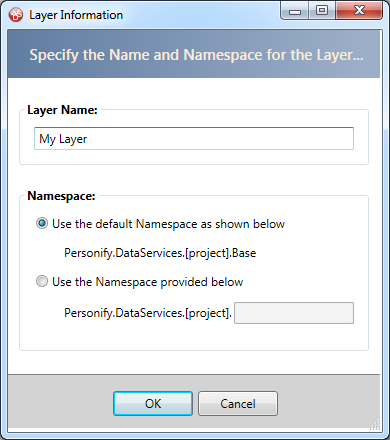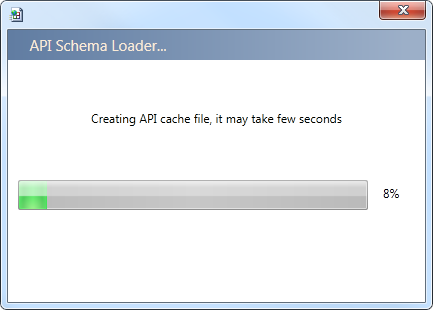
If the Personify WSD is accessed directly by running the executable, the developer has to sign in with the valid Personify credentials, provided that developer has the proper permissions. For more information, please see Web Services Designer Security. When the Personify WSD is accessed from Personify Enterprise "Tools" menu, it skips the authentication and authorization.
When the Personify WSD is opened for the first time against any database, it prompts the developer to create a new layer (Customer layer) to work with, as shown below. Developers will specify a name for the layer and the Namespace. The details are saved in the database.
Personify360 WSD provides an option to stay with the default Namespace
“Base”. In the past, you could only use your own custom Namespace. The
Use the default Namespace as shown below
radio button simplifies the configuration of both Data Services (Web.Config)
and web controls, whereas the Use the
Namespace provided below radio button has some additional steps
in the configuration.

When the Personify WSD is opened for the first time on a computer, it caches the Personify API schema on the local computer in order to provide the best performance and user experience, as shown below. This may take about a minute. Please note that API cache will be automatically rebuilt whenever the Personify WSD observes any changes the Personify API assemblies, including customer layer assemblies. Typically this happens after every upgrade. For more information, please see Upgrading the Personify Web Services Designer.

The Personify WSD loads the library of Entities, Service Operations, and Associations from the selected layer.
See also:
· Web Services Designer Behavior
· Designing Service Elements
o Creating New Read/Write Entities
§ File Uploading via Read/Write Entities
o Creating New Read-Only Entities
o Creating New Service Parameters
o Creating New Service Operations
· Web Services Designer Filtering and Searching Elements
· Web Services Designer Error Handling
· Validating the Service Definitions
· Modifying the Layer Name and Namespace
· Utilizing the Visual Behaviors of the Canvas
· Working with the Element Attributes (Properties Pane)
· Configuring Personify API Validation Issues
· Refreshing the Service Definitions
· Enabling and Disabling Entities
· Exposing Data Services for Data Export / Import